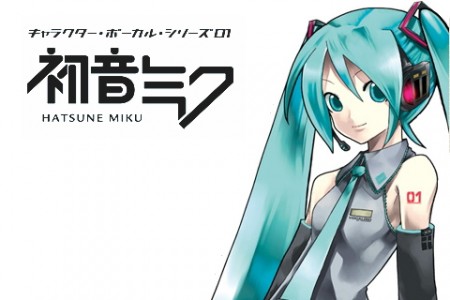Ask John: Why is Hatsune Miku so Popular?
Question:
What is it about Hatsune Miku that otaku find so appealing? Why is she so central to the otaku community?
Answer:
No other character in the history of anime has ever become quite so widely and lovingly embraced by not only otaku but by mainstream Japanese society and the larger world. Hatsune Miku may be the most fascinating character ever to appear in the anime world because so many different attributes concentrate within her persona. By design and circumstance, Hatsune Miku encapsulates and represents a greater spectrum of concepts interesting to otaku than any other character to have ever emerged from the anime/manga universe.
Otaku have been fascinated with the concept of a digital idol since the 1985 OVA Megazone 23. Hatsune Miku is literally a real Eve Tokimatsuri, a completely fictional digital idol singer whose popularity has spilled over into actual mainstream society. Hatsune Miku is, in effect, an anime concept actually developing and existing in real life. But unlike functional robots and mecha suits that have also been developed in real life, Hatsune Miku is more fully developed and functional than robots and mecha suits developed as scientific and industrial experiments, and she’s much cuter. In addition to Hatsune Miku representing anime literally crossing over into real life, she also appeases the otaku fascination with the ideal girl. Miku is cute. She has “twin-tails” and wears “shima-pantsu” – two pig-tails and wears stripped panties – a pair of common otaku fetishes. She’s also totally loyal and devoted to her “master.” Hatsune Miku is a digital avatar who exists to speak and sing the words her master composes for her. She’s the ultimate girlfriend who’s always in whatever mood her master is in, always ready to do her master’s bidding. Because Miku is a digital character, her personality is also always whatever the observer wants it to be. In many depictions, illustrations, and videos Miku is cheerful, and maybe a little ditzy. She also sometimes appears jealous, or violent, or melancholy. When she’s particularly confused or bewildered, she appears in her super-deformed state known as “Hatchune Miku.” Her SD alter-ego is highly amusing and adorably cute in and of itself, which only enhances Hatsune Miku’s appeal. The flexibility of her character allows users to do anything with her. Characters that originate in manga or anime will always be inextricably tied to their origins. While otaku can place Rei Ayanami in new clothes and new settings, we’ll always be conscious of the fact that she’s fundamentally a schoolgirl in a sci-fi anime. Hatsune Miku isn’t tied down by any such roots. Doujinshi manga and video creators have carte blanche freedom to give Hatsune Miku any personality and any background they choose. Hatsune Miku’s voice is high-pitched and cute, like an idealized Japanese teen girl idol, yet her singing still isn’t quite flawless. The slightly stilted, just-barely-noticable artificialness of her singing is part of her charm. Perfection quickly becomes routine and boring. Hatsune Miku’s “almost real” voice inspires a sense of encouraging support. Listeners instinctively want to encourage her, as if with just a little bit more practice, she’d sound exactly like a real human singer. Newer vocaloids with greater technological advancements have been developed, but Hatsune Miku retains a certain loyal fondness because she was the first and because her perpetual almost-perfection always inspires our support, encouragement, and fascination.
Whether or not individual otaku consciously realize her status, Hatsune Miku encompasses and represents a greater accumulation of characteristics appealing to otaku than any other existing singular anime character. She literally embodies the concept of an anime trope emerging into reality. She exists as a perfect fantasy companion that’s always sympathetic, loyal, and accessible. She exudes a persona of whimsical, charming innocence and trust, although her personality is flexible enough to mold to any conceivable situation or attitude. For both Japanese and international observers, she represents the quintessence of modern “Japanese-ness” through her cute, juvenile charm and her existence as a triumph of modern technology. Hatsune Miku is, in effect, all things to everyone. No one need like the show or manga she originated from because she didn’t originate from a particular title or franchise. Thus she is the perfect anime girl that both otaku and mainstream observers can adore and respect.
Add a Comment
You must be logged in to post a comment.



I always assumed the popularity of Vocaloid’s “Character Series”, along with the many things (Ask) John already mentioned, is the participatory nature of the Vocaloid fandom. Anyone can buy the software and whack together a new song & video and contribute to the story of these characters. Where most anime/game/comics products are 1-way lines of communication with the fandom, Vocaloid invites the opportunity for a 2-way dialogue where the fandom can actively expand on the material, which then makes its way back into the official iconography and merchandising (Miku’s onions, Luka’s octopus head, etc.)
I think it’s in that way that Vocaloid primarily differentiates itself as a phenomenon in the general fandom, rather than any particular trait related to the “character” of Miku herself.
As someone who’s actually used Vocaloid in a few songs, it’s actually possible to make Miku etc. sing somewhat expressively and realistically**… there are loads of expression controls in the software if you want to take the time to meticulously sequence them into the voice track. However 99% of Miku tracks go without expression sequencing and opt for the flat robo-renditions of anime pop that Miku is well known for, which works better to avoid the uncanny valley I suppose.
** e.g. 2:30 into this song: http://soundcloud.com/renzu/kamui